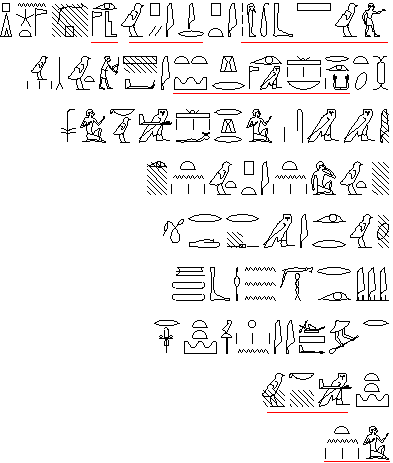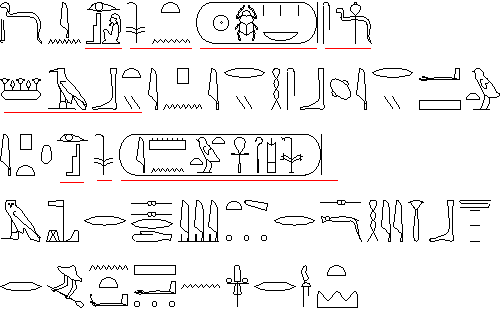|
1)
This exercise represents the shorter formula. The name of
the deceased's mother is mentionned at the end.

The
transcription and translation of the text go as follows:
sHD
wsir
irw ms n tA-Xbs
Illuminate
Osiris Iru
born of Takhebes.
2)
This exercise represents the longer type of formula, as you
probably already derived by its length. The standard parts
of the formula are underlined in red:

The
transcription and translation of the text go as follows:
i
wSb.tj.w
ipt ir ip.wj wsir imj-r p(r)
n dwA.t-nTr p(A)-di-
n.t r ir.t kA.t nb(.t) m Xr.t-nTr
iS.tw sDb.w
im m s r Xr.wt=f mk wi sw
///.tw tn ip.tw tn ir///
///w ir im r srwd
sx.t ir ir mH wDb.wj
r Xnt Sa.j n imn.t(j).t r iAb.t(j).t
mk wi
tn
O,
Ushebties, if Osiris,
the overseer of the house of the Divine Adoratrice, Pa-di-Neith,
calls you
to do any task in the underworld,
(if) obstacles are imposed
there like a man who has his duties, behold you will
/// you shall make yourselves accountable and do ///
/// what is done there, by cultivating
the fields, by irrigating the banks
and by transporting sand from the West to the East
(you shall say:) "Behold, here
I am".
Note
that the text calls upon Ushebties in plural. It has been
found on an Ushebti that is likely to be considered as the
chief of some other Ushebties. It is dated to the later part
of the Late Dynastic Period (26th Dynasty or later).
3)
This text is a variation on both types of formula. The presence
of the cartouches should already have shown you that this
is a royal Ushebti. It belonged to Tutankhamun. In red, I
have indicated the words that you should normally have been
able to recognise.

The
transcription and translation of the text go as follows:
Dd
in wsir nsw (nb-xpr.w-ra) sHD
SAb.tj ipn irj Hsb irj aS.tw
ip.t(w) wsir nsw (twt-anx-imn HqA iwnw Sma)
m Xr.t-nTr r ssrd sx.t r smHj wDb.w
r Xnt Sa n iAb.t r imn.t
Said
by Osiris, the king (Neb-kheperu-re), who illuminates :
"These ushebties, if one reckons, if one cries
or one calls Osiris, the king (Tutankhamun, the ruler of Southern
Heliopolis)
in the underworld, to cultivate the fields, to irrigate the
banks
or to transport sand from East to West".
This
concludes the introductory course to the language of the Ancient
Egyptians. If you have gone through all the lessons, you should
now be able to distinguish between the different types of
signs, transcribe most texts, recognise royal names, names
of gods and some stereotype formulae.
For
those who wish to study hieroglyphs beyond this introduction,
there is a list of recommended books at http://www.geocities.com/amenhotep.geo/bib/
in the section "Language".
|